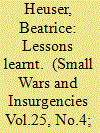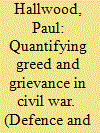| Srl | Item |
| 1 |
ID:
123601


|
|
|
|
|
| Publication |
2013.
|
| Summary/Abstract |
After the Battle of Saratoga (October 1777) in the American War of Independence, British leaders conducted a comprehensive reassessment of their military strategy but examined the new strategy's ways and means without considering the ends or objectives of the war. Using extensive primary sources, this article examines the reassessment process and concludes that the effort was fatally flawed because King George III and his ministers failed to reevaluate the war's objectives, given the changed strategic environment after Saratoga. The resulting British military strategy suffered from an imbalance between ends, ways, and means. Thus, British leaders incurred significant risk in executing their new strategy.
|
|
|
|
|
|
|
|
|
|
|
|
|
|
|
|
| 2 |
ID:
133518


|
|
|
|
|
| Publication |
2014.
|
| Summary/Abstract |
Did participants in small wars in the period 1775-1831 learn from previous or contemporary examples? While this is difficult to prove for participants who left no written records, there is considerable evidence in existing publications by practitioners that they did indeed draw out lessons from recent insurgencies, either from their own experience or from events elsewhere which they studied from afar, especially the Spanish Guerrilla, which had already become legendary. Most authors showed an interest in how to stage insurgencies rather than in how to quell them. Even then, transfer did not come in a package of tactics-cum-values, but in each case in different configurations.
|
|
|
|
|
|
|
|
|
|
|
|
|
|
|
|
| 3 |
ID:
123167


|
|
|
|
|
| Publication |
2013.
|
| Summary/Abstract |
Greed' vs. 'grievance' is weighed using a generally applicable methodology as motivations in the American War of Independence. Greed is quantified as the expected economic benefit of Independence - escaping colonial trade burdens and expected increased economic growth rates. Grievance is measured as willingness to pay to escape perceived political burdens. Quantification of the relative contributions is made possible by using estimates of expected war-costs. To the extent that the economic burden was insufficient to explain the War, the residual is ascribed to the grievance motivation. Both motives are shown to have contributed to the War, but grievance dominates.
|
|
|
|
|
|
|
|
|
|
|
|
|
|
|
|
| 4 |
ID:
121529


|
|
|
|
|
| Publication |
2013.
|
| Summary/Abstract |
During the American War of Independence, the revolutionaries captured thousands of British and German soldiers. Focusing on common German soldiers, this case study explains the various ways in which American revolutionaries turned these prisoners of war into useful enemies for their war effort. To boost morale, revolutionaries staged elaborate rituals with prisoners of war. Congress, the states, and local citizens hired captive soldiers as prisoner-laborers. After the victory at Yorktown in 1781, Congress and the Continental Army recruited German prisoners of war, allowed them to go free after cash payments, and even sold them into indentured servitude to save expenses.
|
|
|
|
|
|
|
|
|
|
|
|
|
|
|
|